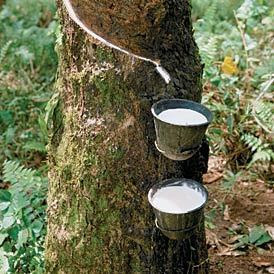Natural Rubber
Natural Rubber
Introduction:
Rubber is the name of a fluid or substance released from a
tree or a bush-like plant grown in the tropical and sub-tropical regions of the
world. It is used for numerous economic and commercial purposes. In beginning,
rubber was obtained only from the forests of the South-American countries such
as Brazil, Ecuador and Peru. The rubber plant which is 30 to 60 feet high
becomes productive in about five years’ time. It remains productive for almost
forty years. The annual average rubber production of one plant is four to six
pounds
 |
| informationmaker.blogspot.com |
History
Before the nineteenth century the world was unaware of the
use of rubber, due to Brazil’s monopoly on rubber. Till 1906, sixty per cent of
the total rubber in the world was produced In Brazil. The use of rubber in the
world began to increase when in 1820; Charles Mackintosh prepared a waterproof
cloth sheet from rubber. Later a scientist named Goodyear made tires and tubes
from rubber. The growing demand for rubber forced the countries to increase
their production. In 1876, an English scientist named Henry Wickham introduced
rubber in Britain and Sri Lanka from Brazil. With the passage of time, the
rubber plant reached Thailand, Indonesia and Malaysia
Types of
rubber
- Balate trees
- Castipoe trees
- Havea trees
Mostly, Havea plant is cultivated in the world because; its
productivity is more than that of all the other plants. Today, it is the chief
source of obtaining rubber and 95 per cent of the world’s total rubber is got
from this type of plant. One hectare of land has 250 rubber plants which
produce 450 kilograms of rubber.

Comments
Post a Comment